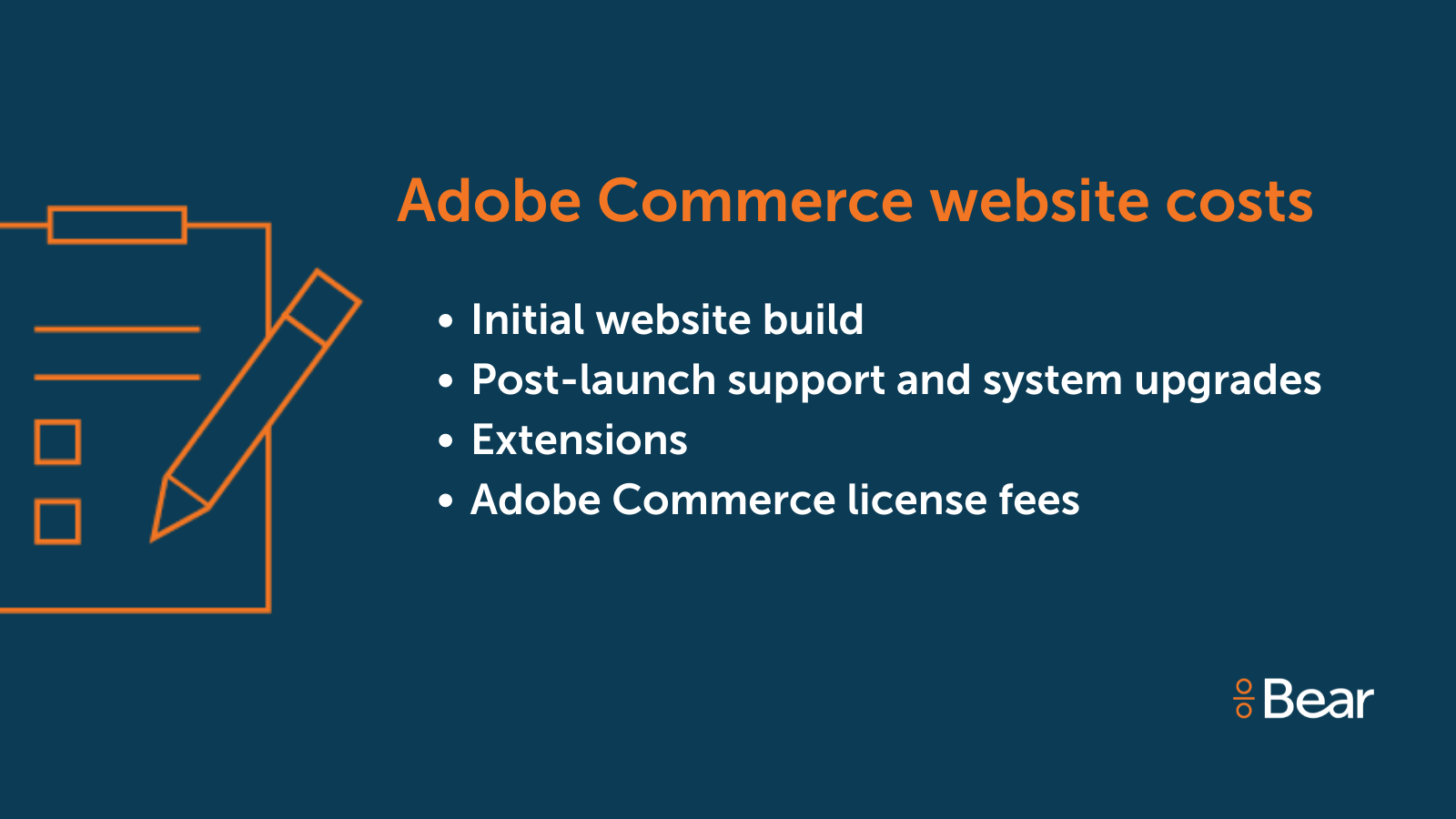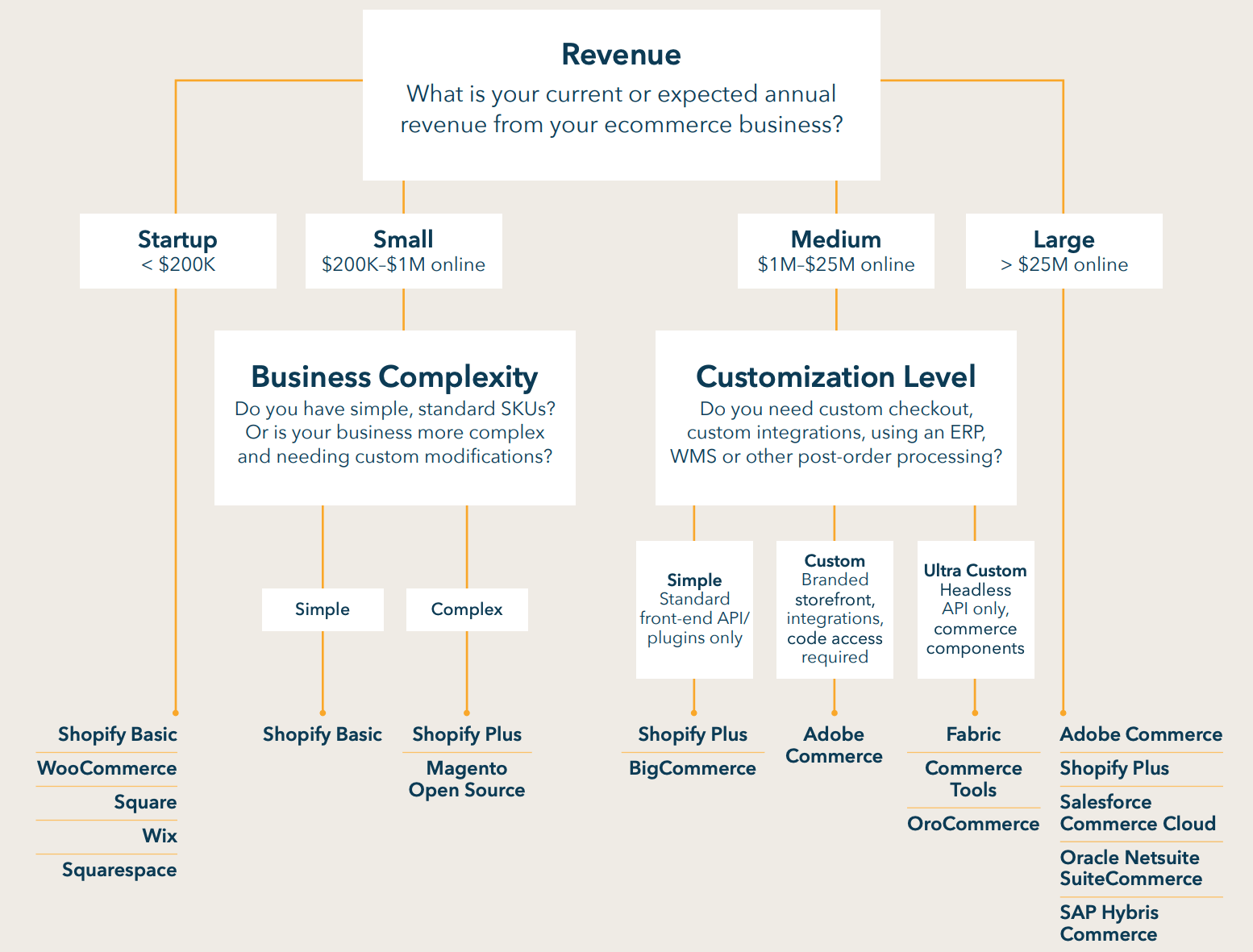Which Ecommerce Platform is Best?
The best ecommerce platform is the one that best meets the needs of your unique business. If you’re thinking of choosing an ecommerce platform for your business but you aren’t sure where to start, we’re here to help.
There are a few key tenants to keep in mind when selecting an ecommerce platform—your selling approach, your expected revenue and all the factors associated with it, and the intricacies of each platform.
Our blog series will break down the contents of our handy Ecommerce Platform Comparison Guide so that you can find the information that best aids in your platform decision-making process.
We’ll compare the important features of Adobe Commerce (Magento), Shopify, Big Commerce, and WooCommerce.
Adobe Commerce (Magento)
Adobe Commerce, formerly known as Magento, is a widely-used ecommerce platform and a great option for mid- and large-sized companies. It is a strong option for merchants who want a custom-branded store and have unique operations and business practices that require some customization.
Adobe Commerce is a licensed Platform as a Service (PaaS) product that comes with a completely managed server environment. It allows your developers full access to the core code and git repository to extend and build upon the foundational code. It is a great choice for businesses doing B2B-type features or B2C needing extensive customization.
PaaS (Platform as a Service) comes from cloud computing where a third-party provider delivers hardware and software tools, which can then be used for application development. The PaaS provider hosts the hardware and software and manages the hosting infrastructure.
Magento Open Source is the non-licensed, free version of the platform. It uses the same API and core code base, but some of the key features that are useful for enterprise clients are missing. For example, B2B accounts/customer management, multi-source inventory, and other features aren’t found in Magento Open Source.
Where Adobe Commerce is Strong
- Adobe Commerce is the most extensible solution with a big out-of-the-box feature set and the ability to be adapted to fit your business needs.
- A strong option if you need a custom import/export, ERP integration, or other backend system integration.
- It’s easy to extend to include business-specific customizations, such as product customizers, subscription systems, complex navigation, or category layouts are all buildable.
- It comes with a solid default theme, it is fully responsive, and can be extended quickly.
- It’s an attribute-based system, meaning you can have as many attributes and attribute sets as needed for various types of products. This is very convenient for complex catalogs.
- There are many third-party solutions for payment gateways, tax, and fraud screening.
- The CMS page builder is great for quickly building custom layouts without coding.
- It has Multi-Source Inventory (MSI) for distributed inventory management.
Adobe Commerce: Total Cost of Ownership
The total cost of ownership with Adobe Commerce can be fairly high based on the level of customization needed during initial development (nearly all clients opt for some form of customization). In addition to up-front development costs, it also has quarterly system upgrades to factor into planning.
- Initial build: Development costs for the initial build can vary widely depending on customization, design, integrations, etc: $60-175,000.
- Post-launch support: Typically heavy support post-launch (2 weeks per month at first) then at least quarterly platform upgrades or patches: $25-40,000 per year.
- Future phases: The platform can be extended to meet any future business needs as they arise.
- Extensions: You may run into various extension fees (usually one-time costs) of around $1,500 depending on what is needed.
- Hosting for Open Source: If you’re using Magento Open Source, you will need to pay for hosting your website at around $2,200 per year (hosting costs are included with Adobe Commerce).
- Adobe Commerce License Fees: Adobe Commerce is a cloud-hosted enterprise product so there are additional license costs.
Shopify
Shopify is a Software as a Service (SaaS) commerce platform, so it includes all hosting and system upgrades. It is a hosted shopping experience with multiple themes and requires very little programming experience to create a basic store quickly.
Shopify was originally built in 2004, but grew steadily throughout the 2010s thanks to its ever-expanding features and ease of use—they found a goldmine in the small business space. There are just over 1.4 million web stores running on Shopify in the United States. Many of these are small, however, we have seen an uptick in commercial and enterprise tiers using the platform.
One of the drawbacks of Shopify is you don’t have access to servers, code, or really anything that Shopify controls—this is also a key benefit that lowers your total cost of ownership because it allows Shopify to push updates and manage the core platform for you. That said, custom development is best to keep minimal, and is not as easy to accomplish as with Adobe Commerce.
Shopify comes in a few price tiers for the standard edition with various features at each level. We recommend using the Shopify payment gateway since it has better transaction pricing.
Where Shopify is strong
- Its technology stack is more modern than the other solutions and boasts a robust API.
- The front-end theme can come together quickly. We prefer to find a similar theme to the current site and Shopify provides enough access to CSS to match the front ends. The Liquid language can be used for any sophisticated front-end needs.
- There is a large app store, containing common integrations and pre-built solutions.
- The built-in predictive search capabilities are fantastic.
- It has pre-built solutions for destination-based taxes, fraud screening, and payments.
- Custom apps can be built and deployed for a single merchant. They can be installed on a single Shopify store. These don’t go through Shopify’s app approval process. They use a “bridge” to appear as an embedded app in the Shopify admin.
- The core Shopify app is built on Ruby and Ruby on Rails, however, that is not what is exposed for developers. When creating your own apps, there are several very modern technologies that are available that make this more approachable.
Shopify: Total Cost of Ownership
The total cost of ownership with Shopify is a little lower than what you’ll see with Adobe Commerce because you won’t see typical self-hosting, patching, and upgrade-related costs. As a result, many smaller sellers can come out slightly ahead with Shopify’s pricing model.
- Initial build: Development costs for the initial build can vary depending on customization, design, integrations, etc: $35-75,000.
- Post-launch support: Expect to need some ongoing external developer support (with the highest support needed soon after launch): $15-25,000 per year.
- Platform cost: Platform costs vary depending on your plan: $299-$2,000 per month.
- Apps: There will be monthly- and/or yearly- subscription model app fees: $100-300 per month.
- Transaction fees: Depending on your plan, you'll have transaction fees for all sales that pass through the site: Anywhere from 2.25-2.9% + $0.30 per transaction.


